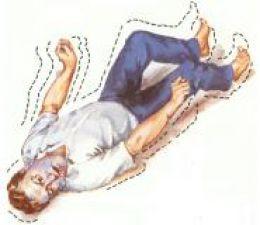Epilepsy and febrile convulsions
Epilepsy is a disruption of brain function that interrupts the normal electrical activity of the brain. Normally, neurons, which are cells that carry electrical impulses, allow communication between the brain and rest of the body. Febrile convulsions occur when a child has a high temperature.
Epilepsy
In epileptics, neurons 'fire' or send electrical impulses toward surrounding cells, stimulating neighbouring cells to fire at one time. This causes an 'electrical storm' within the brain, resulting in physical changes called seizures or 'fits'. It is only when there is a tendency to have recurrent seizures that epilepsy is diagnosed.
 In 70 percent of all cases the cause of epilepsy cannot be identified. Head injuries, strokes, brain tumours, infections such as meningitis, lead poisoning or injury during childbirth mostly cause the remaining 30 percent. There are many different types of seizures.
In 70 percent of all cases the cause of epilepsy cannot be identified. Head injuries, strokes, brain tumours, infections such as meningitis, lead poisoning or injury during childbirth mostly cause the remaining 30 percent. There are many different types of seizures.
The main types of seizures are:
- Tonic-clonic seizures
- Absence seizures
- Complex partial seizures
- Simple partial seizures
Convulsive seizures
Tonic-clonic seizures are convulsive seizures where the body stiffens (tonic phase) followed by general muscle jerking (clonic phase) and involves the whole brain. The person loses consciousness, their body stiffens and limbs jerk. These seizures generally last up to three minutes.
After the seizure the person may want to sleep, have a headache or be confused and disoriented. The person may experience an 'aura' which can precede a tonic-clonic seizure and this may act as a warning giving the person time to seek a safe place before losing consciousness.
Non-convulsive seizures
An absence seizure causes the person to lose contact with their surroundings for about 30 seconds with little or no outward sign that anything is wrong. This type of seizure mainly occurs in children and is often mistaken for daydreaming or lack of concentration.
A complex partial seizure is accompanied by impaired consciousness and recall. It may also involve staring, automatic behaviour such as lip smacking, chewing, mumbling, walking, grunting or the repetition of words or phrases. The person may experience an 'aura' which can precede a complex partial seizure.
A simple partial seizure produces a sudden shock-like jolt to one or more muscles which increases muscle tone and causes movement. These sudden jerks are like those that occur in healthy people as they fall asleep.
Care and treatment
Tonic-clonic seizures ('grand mal')
- Protect from harm
- Place something soft under head
- Loosen tight clothing and any tie
- Roll into recovery position when jerking stops or immediately if vomiting
- Reassure until fully recovered
Do not put anything in the casualty's mouth.
Do not restrain the casualty.
If seizure occurs while the person is seated and strapped in, leave them seated until the seizure is finished. Support their head and neck during the seizure. After the seizure, place in the recovery position if unconscious or if there is food, water or vomit in their mouth.
Absences ('petit mal'):
- Nil active treatment required
- Reassurance
Complex partial seizures (focal):
- Protect from harm
- Reassure until fully recovered
Do not restrain unless at risk of injury
Simple partial seizures
- Nil active treatment required
- Reassurance
One problem encountered by the first aid provider is that of the well-meaning, but untrained bystander. This person may insist the epileptic's tongue should be held before they 'swallow it '. The bystander should be discouraged from actively pulling the casualty's tongue out or placing anything in the casualty's mouth.
Most epileptics understand what happened to them and as soon as they recover sufficiently, they continue on with their business. They do not usually require ambulance care and may become upset when one is called. However, as the first aid provider, you must satisfy yourself the person is recovering normally and there appear to be no complications.
When to call for an ambulance:
- A complex partial seizure lasts longer than 15 minutes
- Another seizure follows quickly
- Food or water is in casualty's mouth during seizure
- It is the first known seizure
- The person has been injured
- The person has breathing difficulties after the jerking stops
- The person is a diabetic
- The person is pregnant and has a convulsive seizure
- The seizure has occurred in water
- The seizure lasts longer than 5 minutes
- The seizure lasts longer than normal for that person
- You are in any doubt
- You arrive after the seizure has started